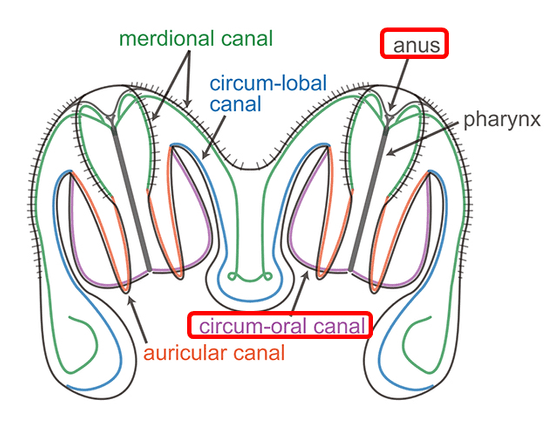Two injured comb jellies 'fuse' into one, a first for animals to become one

Two-headed
Rapid physiological integration of fused ctenophores - ScienceDirect
https://www.sciencedirect.com/science/article/abs/pii/S0960982224010236
After injury, these comb jellies can fuse to | EurekAlert!
https://www.eurekalert.org/news-releases/1059481
Scientists accidentally find deep-sea 'jelly' creatures merged into 'single entity' after injury, revealing bizarre new behavior | Live Science
https://www.livescience.com/animals/scientists-accidentally-find-deep-sea-jelly-creatures-merged-into-single-entity-after-injury-revealing-bizarre-new-behavior
These Freakish Ocean Creatures Can Combine as One When Injured : ScienceAlert
https://www.sciencealert.com/these-freakish-ocean-creatures-can-combine-as-one-when-injured
On October 7, 2024, a research team led by Kei Shirokura of the University of Exeter in the UK reported in the peer-reviewed scientific journal Current Biology that a species of comb jellyfish, the group of animals that branched off the earliest among existing metazoans , has been found to have the ability to rapidly fuse from two individuals into one.
The study was initiated by chance when the team discovered that one day they had lost one comb jellyfish in their saltwater tank, and found an unusually large one in its place.
'I was so excited when I found the comb jellyfish,' recalled Shirokura, the paper's lead author. 'I immediately took the fused comb jellyfish out of the room and showed it to the other researchers.'
When the researchers observed this unusually large specimen, they noticed that it had two posterior ends, as well as two sensory organs called apical organs.
The research team suspected that two injured individuals had fused together, so they actually removed parts of 20 comb jellies collected from different locations, paired them up and placed them in an aquarium. Nine out of 10 pairs fused overnight.
The fused comb jelly responded with its entire body to external stimuli, such as being poked, demonstrating that its nervous system is connected.
Poked!! pic.twitter.com/of4nzjqTAg
— Kei Jokura (@Ctenophore18) October 7, 2024
The fused comb jellies moved separately for the first hour, but soon began to synchronize their movements, and after just two hours, 95% of their muscle contractions were perfectly synchronized. In addition, when they were fed fluorescently colored shrimp, the digestive organs were also fused, and it was found that the food consumed was digested in both stomachs.
'The fused comb jellyfish has two mouths. When it feeds on one side, the digested material is transferred to the adjacent digestive tract,' Jokura explains.
Interestingly, the food ingested through both mouths was eventually expelled through both anuses, but at separate times.
Below is a diagram showing the structure of a fused comb jellyfish. The purple part is the peristomal canal, or mouth, and on the opposite side is the anus.

The fused comb jellies behave as if they are one individual, but their DNA is separate and they cannot pass on the two forms to the next generation, so biologically they are not a single organism. 'However, when you look at the way the fused individual swims, it really does look like it is functioning as a single organism, so it's not unreasonable to think that way,' said Shirokura.
According to Shirokura, there have been no reports of fusion occurring in other species, and the researchers believe this is the first known instance of a creature with the ability to fuse in this way.
It is not yet known whether comb jellies in the wild can fuse, but the research team points out that the ability to fuse is an evolutionary advantage. 'One advantage of fusion is that it allows them to recover from damage much faster than regeneration,' said Shirokura.
The fused individuals were healthy until the research was stopped three weeks later due to lack of funding. The research team hopes to elucidate how comb jellyfish's nervous systems are able to fuse so quickly, and use this knowledge in regenerative medicine and to develop techniques to reduce rejection during transplant surgery.
'The mechanism of inter-individual recognition is linked to the immune system, and fusion of the nervous system is closely related to regeneration research. Elucidating the molecular mechanisms underlying this fusion will help advance these important research fields,' said Shirokura.
Related Posts:







